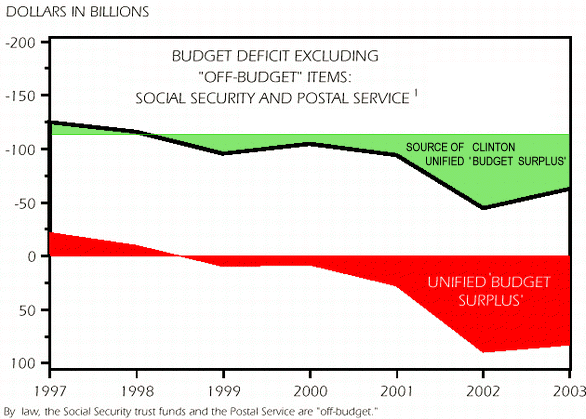

Tuesday, February 3, 1998
The 1999 Daily Republican Tax Payer's
By Howard Hobbs, Daily Republican Contributing Editor
WASHINGTON DESK - Where does the Clinton administration spend the U.S. tax dollar? In a typical American household, a father and mother might sit around the kitchen table to review the family budget. They might discuss how much they expect to earn each year, how much they can spend on food, shelter, clothing, transportation, and perhaps a vacation, and how much they might be able to save for their future needs.
If the Clinton administration ends up with not enough money to make ends meet, he will not openly discuss how he can spend less, as the typical American family does. The president, instead, issues an executive order allocating Social Security trust fund money to cover the deficit.
Chart 1. Family Budgeting vs. Clinton Spending Power
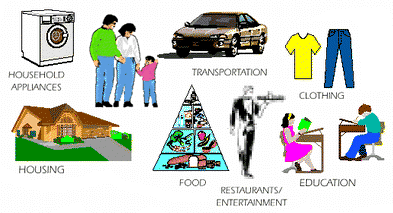
The Clinton administration only lays-out its ideal budget, and borrows against Social Security funds when the ideal budget fails to correctly estimate income vs. expenditires. This is the moral equivalent of an American family who just keeps on charging against its credit cards to maintain its standard of living during periods of unemployment or natural disaster. The president and Congress make a guesstimate of how much money they expect the government to receive from Social Security and income tax in each of the next several years.They will also estimate how many tax dollars to spend to reach their goals—goals for national defense, foreign aid, social insurance for the elderly, health insurance for the elderly and poor, law enforcement, education, transportation, science and technology, and others.
The president wants the Congress to finance his initiatives through raising more taxes and by borrowing from Social Security funds that should be set-aside to pay future benefits. The Congress debates how to use the budget to help the economy grow without redistributing income and how to reduce spending in order to eliminate the deficit and balance the budget and reduce taxation.
Chart 2. Clinton Spending Initiatives vs. National Budgeting Priorities
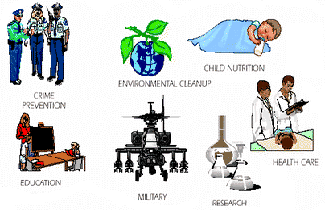
The money that the Federal government uses to pay its bills—its revenues—comes mostly from taxes. In recent years, revenues have been lower than spending, and the government has borrowed from Social Security to finance the difference between tax revenues and Cltnton's budget deficit.
Chart 3. The Clinton 1999 Tax Dollar
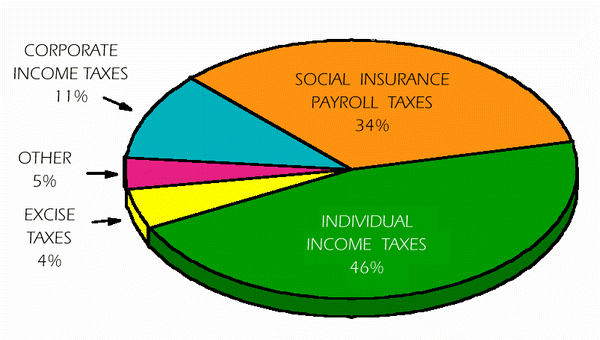
How Clinton looks at Tax Revenue Sources:
- Individual income taxes will raise an estimated $791 billion in 1999, equal to about nine percent of GDP —slightly higher than the average of the last 40 years.
- Social insurance payroll taxes—the fastest growing category of Federal revenues—include Social Security taxes, Medicare taxes, unemployment insurance taxes, and Federal employee retirement payments. This category has grown from two percent of GDP in 1955 to nearly seven percent in 1999.
- Corporate income taxes, which will raise an estimated $198 billion, have shrunk steadily as a percent of GDP , from 4.5 percent in 1955 to 2.3 percent in 1999.
- Excise taxes apply to various products, including alcohol, tobacco, transportation fuels, and telephone services. The government earmarks some of these taxes to support certain activities—including highways and airports and airways—and deposits others in the general fund.
- The government also collects miscellaneous revenues—e.g., customs duties, Federal Reserve earnings, fines, penalties, and forfeitures.
Chart 4. Composition of Revenues
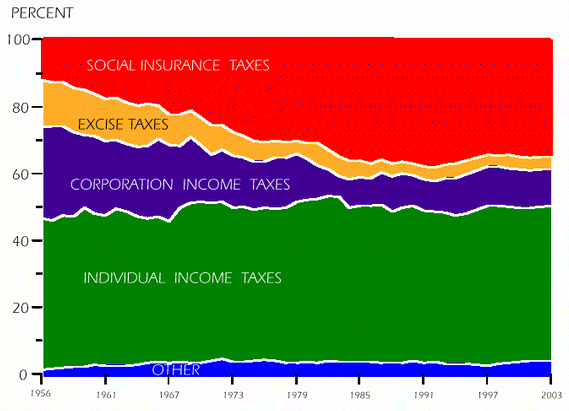
Between 1960 and 1997, payroll taxes have increased substantially as a percent of GDP , and corporate income taxes have declined, but individual income taxes have remained roughly constant. Chart 5. Revenues as a Percent of GDP — Comparison With Other Countries
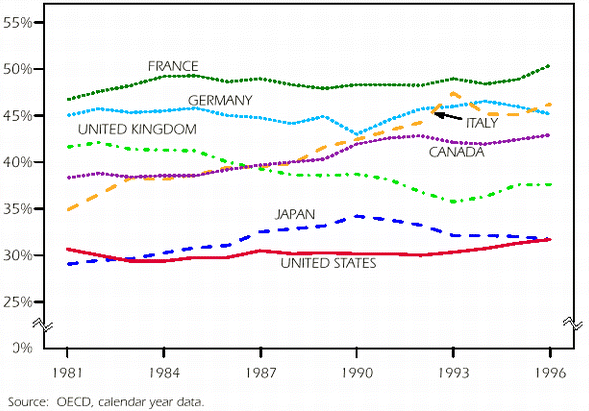
The United States and Japan have the lowest revenues as a percent of GDP of the seven countries listed above. Spending
As has been shown above, the Clinton administration wants to spend over $1.7 trillion in the year 1999. [See eight speending categories in Chart 6.]
Note: In calculating Clinton's spending initiatives, he deducts collections (revenues) generated by the Clinton administration's fee charging activities, such as entry-use fees to national parks. These collections will total an estimated $210 billion in 1999. Without them, spending would total an estimated $1.9 trillion in 1999, not $1.7 trillion.
Chart 6. The Clinton Administration Tax Dollar 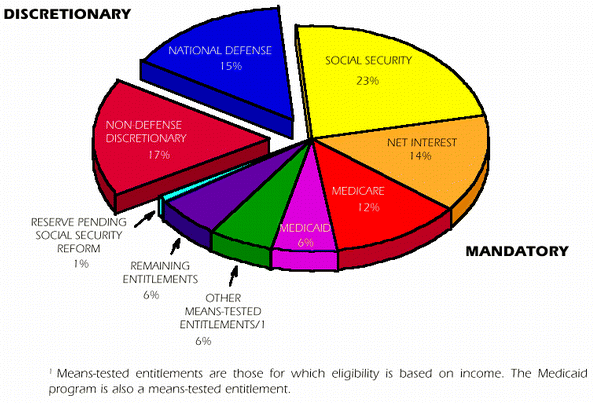
- The largest Federal program is Social Security, which will provide monthly benefits to nearly 45 million retired and disabled workers, their dependents, and survivors. It accounts for 23 percent of all Federal spending.
- Medicare, which will provide health care coverage for over 39 million elderly Americans and people with disabilities, consists of Part A (hospital insurance) and Part B (insurance for physician costs and other services). Since its birth in 1965, Medicare has accounted for an ever-growing share of spending. In 1999 it will comprise 12 percent.
- Medicaid, in 1999, will provide health care services to over 35 million Americans, including the poor, people with disabilities, and senior citizens in nursing homes. Unlike Medicare, the Federal government shares the costs of Medicaid with the States, paying between 50 and 83 percent of the total (depending on each State’s requirements). Federal and State costs are growing rapidly. Medicaid accounts for six percent of the Federal budget.
- Other means-tested entitlements provide benefits to people and families with incomes below certain minimum levels that vary from program to program. The major means-tested entitlements are Food Stamps and food aid to Puerto Rico, Supplemental Security Income, Child Nutrition, the Earned Income Tax Credit, and veterans’ pensions. This category will account for an estimated six percent of the budget in 1999.
- The remaining entitlements, which mainly consist of Federal retirement and insurance programs and payments to farmers, comprise six percent of the budget.
- National defense discretionary spending will total an estimated $267 billion in 1999, comprising over 15 percent of the budget and three percent of GDP .
- Non-defense discretionary spending—a wide array of programs that include education, training, science, technology, housing, transportation, and foreign aid—has shrunk as a share of the budget from 23 percent in 1966 to an estimated 17 percent in 1999.
- Interest payments, primarily the result of previous budget deficits, averaged seven percent of Federal spending in the 1960s and 1970s. But, due to the large budget deficits that began in the 1980s, that share quickly doubled to 15 percent, where it stands today. As the budget comes into balance in 1999, interest payments will drop to an estimated 14 percent.
On-Budget and Off-Budget
The Clinton administration keeps some spending programs off-budget, meaning that the the president categorizes them separately from other programs.
Specifically, the law requires that the spending and revenues of two Federal programs, Social Security and the Postal Service, be excluded from the budget totals—that is, categorized as off-budget. Therefore, the budget displays on-budget, off-budget and unified budget&totals to satisfy this legal requirement.
The unified budget is the most useful display of the Clinton administration’s finances; it is vital in calculating how much the Clinton administration must borrow from Social Security to cover his spending gaps.
The off-budget maipulation is designed to hide the fiscal effects of Social Security and other programs. Over the years, the government has placed numerous programs &off-budget then returned them to the unified budget. But the mere listing of programs as off-budget does not, by itself, protect them from the budget process, at all. The Clinton administration is carefully reviewing those programs fpr possible hidden cuts, and un-advertized hiring and procurement from non-competitive government contractors and friends.
Chart 7 illustrates the relationship between on-budget and off-budget items, and the unified budget.
Chart 7. On-Budget and Off-Budget Deficit Projections 